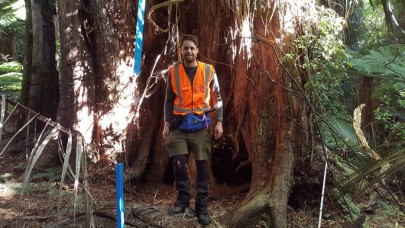Myrtles for tomorrow - researchers to share updates
The symposium, titled “Myrtles for Tomorrow: Myrtle Rust Research Updates” will take place on Monday, 2 December 2019, the first day of the conference.
BMR Project Manager Renee Johansen has curated a rich programme for the conference, featuring research presented by 11 researchers hailing from organisations such as Manaaki Whenua – Landcare Research, the BioHeritage Challenge, Department of Conservation, Plant & Food Research, AgResearch, and Scion.
The symposium’s focus is to provide an overview of the research being conducted in the myrtle rust space, from the $3.7 million of research funded by the Ministry for Primary Industries and completed earlier this year, to projects currently being undertaken by a variety of organisations, including the Beyond Myrtle Rust Programme, run by Manaaki Whenua – Landcare Research and funded by the Ministry of Business, Innovation & Employment.

James McCarthy in the field
Finding management solutions
James McCarthy, a plant ecologist at Manaaki Whenua’s Lincoln campus, is one of several people presenting at the symposium. James uses modelling techniques to describe plant community distributions and make predictions about how community distribution may change in the future, especially under predicted climate change scenarios.
“For the myrtle rust work,” says James, “we’ve been producing distribution models for plant species that may be susceptible to myrtle rust.”
James will be presenting work he and his colleagues have been doing to identify myrtle rust refugia, geographical areas where susceptible plant species might occur outside the range of the disease itself.
“Even if myrtle rust is detrimental to native plant species,” says James, “they may still have a decent chance of persisting in natural settings through these refugia.”
James’ work initially received funding from MPI. Now, Beyond Myrtle Rust has taken up the funding. The programme is continuing funding for several projects like James McCarthy’s and they are also funding new projects. This has created an environment of growth in the myrtle rust research community that is facilitating continued research towards finding solutions for managing the disease.
Strengthening the myrtle rust community
McCarthy is looking forward to hearing what other researchers have been finding out about myrtle rust.
“We’re not always completely up to date with each other’s projects. This is a great opportunity for myrtle rust researchers to connect and share ideas.”
It’s also a good opportunity to communicate with the broader ecological community and wider public. As the preeminent annual conference of the NZES, the symposium is a fantastic opportunity to reach as many New Zealand ecologists as possible.
“There will be over 250 attendees representing over 50 organisations. Since they won’t all be plant ecologists or forest ecologists, they may not be following the research that’s been going on too closely. This is a great way for them to be filled in.”
Fire symposium
Besides the symposium, James is looking forward to the fantastic programme of this year’s conference. He has been a member of NZES for close to ten years and enjoys the annual conferences so much that he is one of people on this year’s organising committee.
In particular, he’s looking forward to the keynote speakers, the fire symposium (which he thinks is particularly relevant especially after the 2017 Port Hills fires around Christchurch and the current fires in Australia), and the symposium “Enhancing Functional Biodiversity in Agroecosystems.” This symposium will examine the value of enhancing biodiversity in agricultural systems in terms of maintaining ecosystem services and functions that biodiversity provides.
“It will be interesting to explore the importance of biodiversity not only in natural settings, which is what we usually think of, but in agricultural settings as well.”
Focus on mātauranga Māori
Another highlight of the conference will be the launch of a special issue of the New Zealand Journal of Ecology on Mātauranga Māori. The issue recognises and celebrates the importance of including mātauranga Māori and Māori communities in scientific, environmental and policy processes to enhance understanding of ecology and guide the development of research, management and policy.
For more information on the NZES, the conference or the myrtle rust symposium, please visit the NZES conference website.
